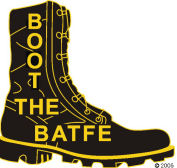

SCOTUS hears oral
arguments in bump stock case

By NRA-ILA. Mar 4, 2024
On February 28, the U.S. Supreme Court heard arguments in the case Garland v. Cargill, concerning ATF's 2018 rule classifying bump stocks as machineguns. The case involves firearms parts but does not hinge on the Court's interpretation of the Second Amendment. Rather, the case concerns the proper interpretation of federal statute and the amount of deference, if any, the administrative state should be given in interpreting federal statutes to their own ends.
Federal law precisely defines machinegun. 26 U.S.C. § 5845(b) provides,
The term "machinegun" means any weapon which shoots, is designed to shoot, or can be readily restored to shoot, automatically more than one shot, without manual reloading, by a single function of the trigger. The term shall also include the frame or receiver of any such weapon, any part designed and intended solely and exclusively, or combination of parts designed and intended, for use in converting a weapon into a machinegun, and any combination of parts from which a machinegun can be assembled if such parts are in the possession or under the control of a person.
Firearms or parts that meet this definition may only be transferred pursuant to a background check of the transferee, procurement of a $200 tax stamp, and the firearm must be registered in the Bureau of Alcohol, Tobacco, Firearms and Explosives' National Firearms Registration and Transfer Record. Further, federal law prohibits civilian possession of machineguns manufactured after May 19, 1986.
A "bump stock" is an aftermarket device that replaces the standard stock on a commonly–owned semi-automatic rifle, such as the AR-15 or an AK-pattern rifle. The key feature of this item is that it allows for the firearm to slide backwards and forwards within the stock. When the rifle is fired, the recoil pushes the firearm further into the stock. When used as its manufacturer intended, the operator pushes forward on the rifle's forend when firing, allowing the rifle to repeatedly slide backwards and then forwards into the operator's trigger finger. As this maneuver constitutes separate "single function[s] of the trigger" for each shot fired, the items should not be considered machineguns under the federal definition. This same effect (bump-firing) can be achieved in numerous ways, perhaps most famously with a belt loop.
In 2010, ATF evaluated the leading bump stock manufacturer's product and determined that the device was not a machinegun. ATF wrote,
..... 
![]()
























